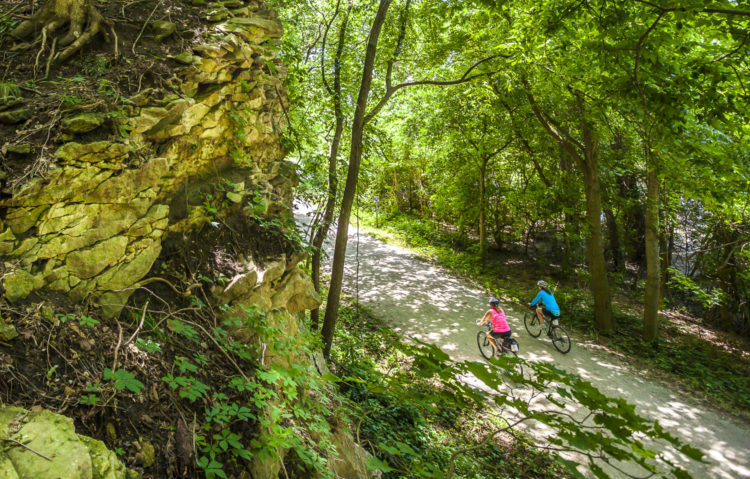It’s only natural to tell others about a recent fun time you’ve had while hiking, biking, or running a trail. Showing them your good time is faster, of course, and it can be more effective, but only if your photographs convey a real sense of the place, the people, and the activity you enjoyed.
You’re probably thinking: “Tell me something I don’t already know.” OK, how about the definition of the word photography? We all know what a photograph is, but the word actually means writing with light: “photo” (light) and “graphy” (writing).
Try this experiment. Imagine the words you’d use when telling someone from, say, New Mexico what it’s like to pedal a dirt trail through a sometimes-tunnel of trees overhead, with steep bluffs on one side and glimpses of the Missouri River through forest and thick undergrowth on the other. You’ll need to mention the many shades of tangled greenery, the orange and yellowish hues of the bluffs, the bright colors of fellow bikers…. Or you could send your New Mexico friend the Katy Trail photo above, which writes that scene in a glance.
Poorly chosen words when describing a place and activity leaves your audience unmoved. Likewise, poorly chosen words of light keep your audience in the dark. So the first — and most important — technique to improve our shooting when in the wilds is to think before we snap: “What do I want this image to say?” Then try to compose a photo that includes the “words” that say it.
Next in importance, similarly non-technical but also critical, is how to hold the camera. As they’ve gotten smaller, they’re harder to hold still, especially when you’ve just hiked to some gorgeous Ozark overlook or paused during a trail run and are a bit out of breath. Blurring the photo by moving the camera when clicking the shot, shooting a piece of a finger as part of the scene, or failing to notice perspiration or dust on the lens are common mistakes and easily avoided.
Try spreading your legs shoulder-width and tucking your elbows into your sides, then pressing the camera (or camera-phone) snug against the forehead while holding the camera securely with both hands. Avoid photographing your fingertip by practicing holding the camera to your face before you use it in the field. And, along with an extra battery and memory card (and a Ziploc bag to keep everything dry), always carry an inexpensive retractable lens brush and tiny cleaning cloth. Exhaling on the lens will produce enough moisture to remove spots that the brush can’t clear.
Finally, try not shooting friends against a background but within it, by stepping off the trail or climbing (carefully) up or down for a different angle on the scene. Then fill the frame with what you want to say — and snap!
Author: Dennis Coello
Image: Dennis Coello


Leave A Comment